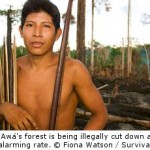 “Sustainability of forests – the most precious natural resource – has far greater environmental significance in current times, since they contribute in mitigating global climate change for longer periods by acting as carbon sinks and absorbing atmospheric carbon dioxide. Unfortunately, forests are degrading at a faster rate than ever before due to conversion of forest land for non-forest use, despite two key initiatives adopted by countries worldwide – CDM and REDD – which have some inherent discrepancies. Hence, major efforts are required to implement only those forestry projects that favour ecological sustainability.”
“Sustainability of forests – the most precious natural resource – has far greater environmental significance in current times, since they contribute in mitigating global climate change for longer periods by acting as carbon sinks and absorbing atmospheric carbon dioxide. Unfortunately, forests are degrading at a faster rate than ever before due to conversion of forest land for non-forest use, despite two key initiatives adopted by countries worldwide – CDM and REDD – which have some inherent discrepancies. Hence, major efforts are required to implement only those forestry projects that favour ecological sustainability.”
Introduction:
Global warming is a phenomenon that directly or indirectly touches all walks of life. Climate change – an impending consequence of unabated global warming – has kicked-off furious discussions amongst scientists, corporate, politicians and social activists over past few decades. This has assumed serious proportions and very few could have visualized that the glittering dawn of 21st century would soon pale away under the smoky clouds of the industrial-revolution era.
Global warming can be better understood as an unforeseen consequence of rapid industrialization, urbanization, mindless consumption of natural resources, and use of non-eco-friendly technologies. The ubiquitous human involvement has been through activities like coal mining, illegal logging and burning of fossil fuels – that are largely responsible for environmental degradation.
 Ever since the industrial revolution era, development has been made in leaps and bounds but at a huge environmental cost. Natural resources like forests have been depleted and degraded, water resources have been exploited and polluted, industrial and vehicular emissions have increased air pollution. The current situation is that planet Earth has warmed up considerably. It’s undoubtedly a million dollar question as to how to put a stop to further warming of the planet.
Ever since the industrial revolution era, development has been made in leaps and bounds but at a huge environmental cost. Natural resources like forests have been depleted and degraded, water resources have been exploited and polluted, industrial and vehicular emissions have increased air pollution. The current situation is that planet Earth has warmed up considerably. It’s undoubtedly a million dollar question as to how to put a stop to further warming of the planet.
To achieve this goal, every nation has to take proper policy decisions and lay down mandatory environmental laws. Flouting environmental guidelines has become a common practice in both the developed and developing countries. The need of the hour demands sustainable use of natural resources and use of environment friendly technology.
Sustainability of forests – the most precious natural resource – has far greater significance. First, forests contribute in mitigating global climate change for longer periods. Forests store carbon in biomass and soils, thus, acting as reservoirs. Second, when productivity is increased, they absorb more of atmospheric carbon dioxide and, thus, act as carbon sinks.
Unfortunately, forests are degrading at a faster rate than ever before due to conversion of forest land for non-forest use, despite two key initiatives – CDM (Clean Development Mechanism) and REDD (Reducing Emissions from Deforestation and Forest Degradation) adopted by countries worldwide. These initiatives from United Nations came into existence with the Kyoto Protocol, adopted by the third Conference of the Parties (COP) to the Framework Convention on Climate Change (December 11, 1997 under Article 12). However, both the schemes suffer from several inherent discrepancies.
Clean Development Mechanism (CDM):
Forestry carbon credits available under the CDM motivated corporate to develop and execute monoculture plantation projects in a bid to offset their emissions. ‘Sustainability’ – that was supposed to be the key element in such projects – was side-stepped for various peripheral reasons. An analysis of the relative advantages of single-species and mixed-species plantations makes it clear how CDM-based forestry carbon credits have in fact led to much confusion and to further environmental degradation.
- In single species plantations, mostly exotic (non-native) species like eucalyptus, Pinus and Tectona were used by project developers. These are fast growing and act as a threat to indigenous species. These species are highly susceptible to stress and adverse climatic conditions. On the other hand, mixed species plantations include indigenous species like Agathis, Acacia and broad-leaved deciduous trees that have slow growth rates and are less susceptible to environmental stress.
- Monoculture plantations lack plant and animal biodiversity, aptly referred to as ‘green desert’, while mixed plantations support biodiversity, local animals and habitats. Thus, monoculture forests do not provide a replica of an actual forest, while mixed plantations ‘mimic’ actual forests.
- Monoculture plantations are low cost projects and are commercially beneficial whereas mixed plantations are highly expensive but they store carbon over many years. They are ecologically beneficial.
- Resistance to disturbance: Monoculture plantations – if dominated by conifers, the resident understory assemblage, which is dominated by late succession species – are susceptible to gap formations and, thus, their structure would be permanently altered, whereas, in mixed plantations, if dominated by deciduous tree species, the impact of disturbance does not alter the structure because the understorey is dominated by species which benefit from the new conditions and, thus, increase in abundance (Grandpre and Bergeron, 1997).
- Species like Eucalyptus and conifers remove too much underground water from reserves and streams, using lot of water for their growth; affect soil fertility and are not good habitats for wildlife, whereas, mixed plantations remove relatively less underground water and maintain soil integrity.
- Monoculture plantations of Eucalyptus species have thin crown and open canopies leading to low interception of rainfall water, whereas indigenous tree species relatively intercept more rainfall water.














